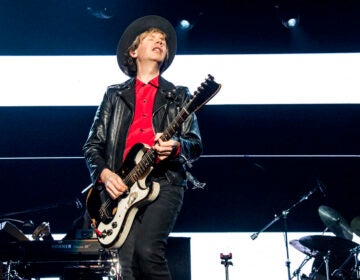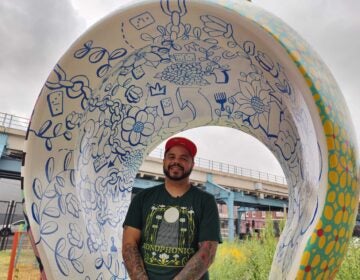The Mexican revolution will be muralized
ListenThe Mexican Revolution of 1910, depicted in films and photos with Pancho Villa riding his ferocious horse Siete Leguas. Men and women with bullet belts criss-crossing their chests stood proudly for the photographers as they fought a brutal war to overthrow the tyranny of Porfirio Diaz. The monumental change in politics fostered an equally transformative cultural movement best represented by enormous murals.
So to tell the complete story of this art revolution The Philadelphia Museum of Art faced a problem: how to convey the power of those murals. short of transporting one into the building?
Mathew Affron, the Museum’s Curator of Modern Art , says that’s where design ingenuity came into action
“We sent teams to Mexico City to make new photography, digital photography of three great murals, Diego Rivera “Ballads of the Revolution,” from the Education Ministry of Mexico City is the first of those. So what visitors see in the exhibition is a floor-to-ceiling, full-scale visual projection which will allow you in effect is to walk alongside a very high-quality reproduction and we think that this replica will give audience a feel of what mural painting is that cannot be accomplished any other way,” Afron said.
Nearby a large digital table allows the visitor to zoom in on the images and the red ribbon with the words of revolutionary ballads Rivera painted in his mural.Similar techniques were used to depict the interior of a staircase, painted by Alfaro Siqueiros in the Electricians Union building in Mexico City. In an innovative use of space, the mural runs on three walls and the ceiling.
“So,” says Affron, “it goes not from left to right and right to left but really vertical, from bottom to top. As you walk up the stair along this mural, what you see are panels that allegorize the forces of capitalist, fascism and war fighting with each other,” he said.
The drawings, paintings, posters, publications and murals show how artists collaborated with the revolutionary government and popular cultural institutions to create a new visual language — a language that depicted the struggles of working people and farmers, and their hopes for a new country.
“What you had is the coming together of a generation of ambitious and innovative artists with a social mandate” said Affron.
For the exhibition’s poster, the Museum chose a painting by Frida Kahlo, but not the work of a woman preoccupied by her personal woes. This is the revolutionary painter who depicts the struggles of a country’s growing pains. Dressed in a pink dress and holding a small Mexican flag in her hand she becomes the border between the two countries and each side of her tell a different story says co-curator Mark Castro
“To one side of her you see these symbols of the U.S.A. Sky scrapers, the Ford car factories in Detroit that she visited with her husband when he was working on the Detroit industry murals, an American flag that appears in the smoke of the smoke stacks in a factory,” he said. “Then on the left you see a pre-Columbian pyramid, rich and lush flowers and rich vegetation whose roots you see reaching into the soil. It captures how she felt when she was traveling between the two countries.”
Behind the entire exhibition a questions comes to mind: is art in the service of a cause or even a government a form of propaganda? Possibly says curator Mark Castro.
“What’s important and what the show can do is open your eyes to both the possibilities and the problems of art that has a very specific goal , there are a lot of possibilities for greater dialogue for messages behind the art and about the way in which those messages are depicted,” Castro said.
Mathew Affron adds that “what you are not going to see in this exhibition is stereotypes.”
He wants you to discover that the risk taking and daring of these artists pointed to an original vision for the Americas that attracted people ranging from artists to industrialists from all over the world.
“Because it was felt that something new was coming out of Mexico and that was a great creative, innovative, socially-oriented, morally consequential culture, and everybody understood that it was very relevant for thought times,” he said.
You have only to see some of the drawings and paintings in the Paint The Revolution exhibition to get an idea of how relevant.
WHYY is your source for fact-based, in-depth journalism and information. As a nonprofit organization, we rely on financial support from readers like you. Please give today.























